ALL YOU NEED TO KNOW TO SUCCEED IN THE FOLLOWING 9 MONTHS
If you are pregnant for the first time you’ll probably have many questions and be a little scared. You want to do everything right to keep your baby (and yourself) safe. Also, you want to understand what’s normal and what should make you worry. That way you can ask for help if you need it, or relax if there’s nothing to be afraid of. In this article, we’ll explain all the basic facts you must know, as well as the most important recommendations for a healthy pregnancy.
[box type=”shadow”]
Some Pregnancy Basics
2. Can You Prevent a Miscarriage?
4. Exercise during pregnancy: Good or Bad?
The Pregnancy Timeline
Pregnancy & Health
7. I Have Some Preexisting Conditions… Is It Gonna Be OK?
8. The Enemy: Pregnancy Complications
[/box]
1. Are You Really Pregnant?
The most reliable way to find out if you are pregnant is the pregnancy test. There are some symptoms that may suggest that you are pregnant, but they are not specific. Besides, they sometimes happen later on in pregnancy, and not in the beginning.
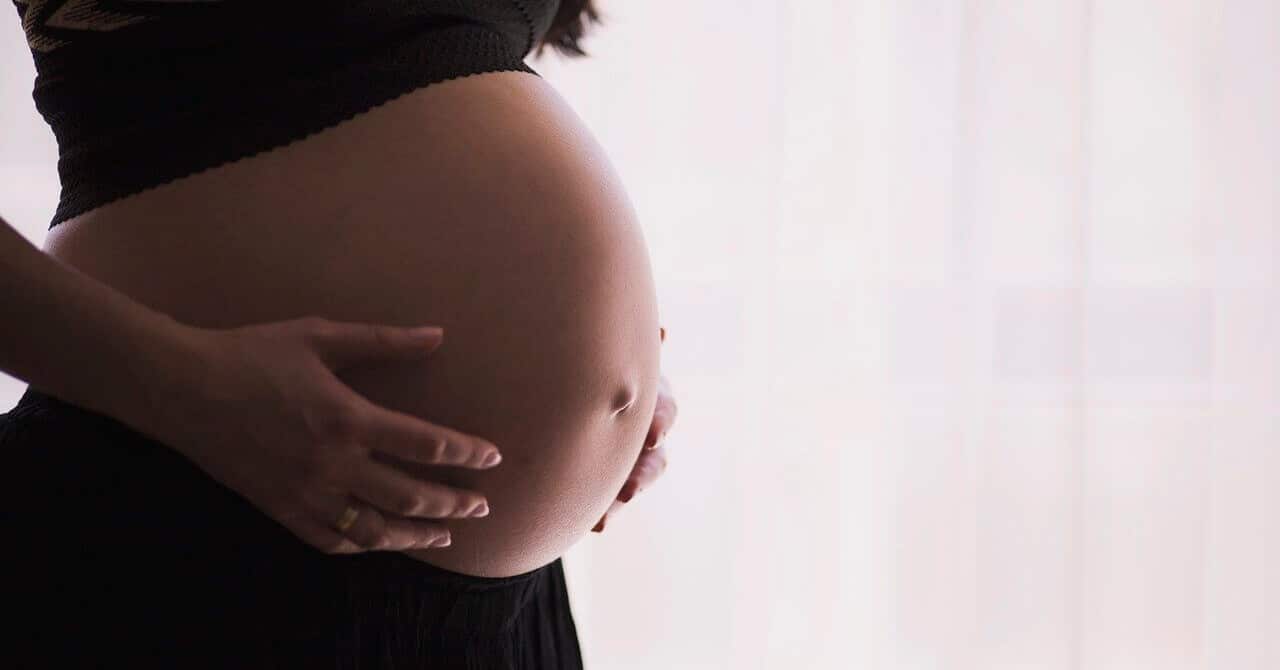
If you miss your period, that might be the first sign that you are pregnant. However, many girls have irregular cycles. If your period delays for more than a week, take the pregnancy test.
The most common symptoms of pregnancy in the beginning are:
- Nausea: you can feel nausea or even vomit after 4-6 weeks. By this time, you should have noticed that you missed at least one period.
- You feel extremely tired and have a low mood: you don‘t know why, but you feel exhausted and a little depressed. It is due to the new hormonal balance in your body. This is especially true during the first trimester.
- Food tastes and smells weird: some smells bother you (like the smoke from cigarettes) and food tastes different than before. You may also crave for new food, or food you never liked very much.
- Your breasts feel bigger and hurt: again, due to your hormones, which will be progressively increasing.
- Increased vaginal discharge: it can be one of the earliest signs, even before missing your period. As pregnancy goes on, the discharge will increase and become thicker. Normal discharge should be clear or whiteish and with almost no smell. If it has a different color or a strong smell, go see your doctor. It could also be an infection.
If your period delays more than a week, take the pregnancy test
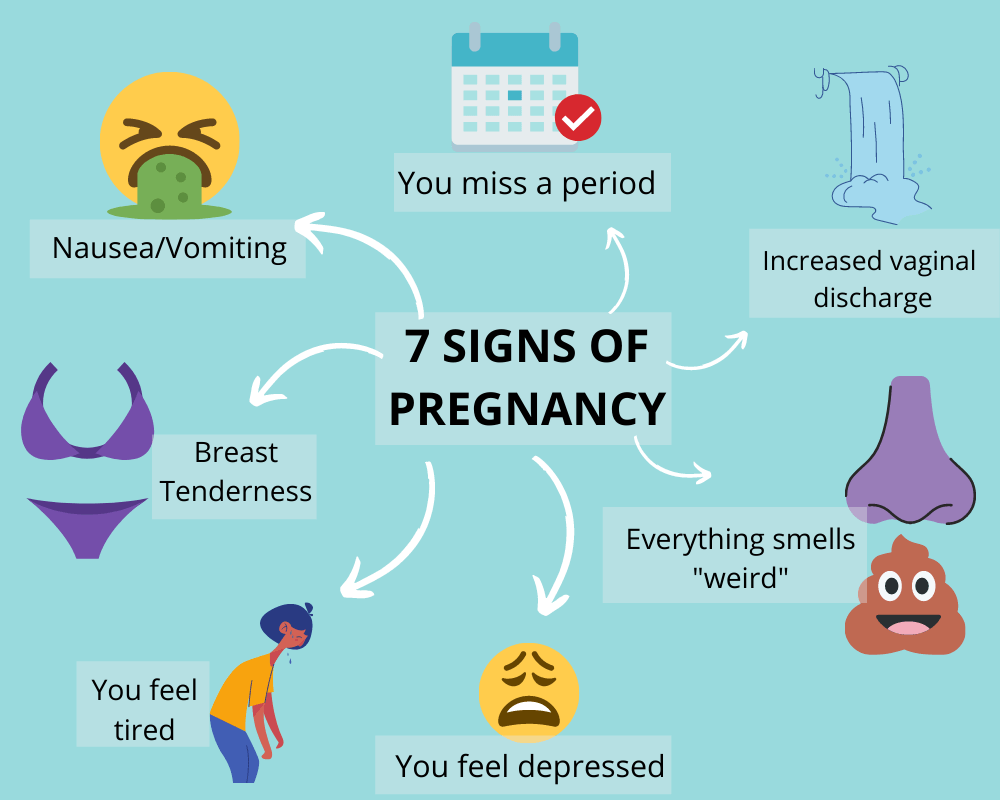
2. Can You Prevent a Miscarriage?
Most miscarriages can’t be avoided. They just happen.
The first sign of miscarriage is vaginal bleeding. However, in the first months of pregnancy, it is quite normal to have some light bleeding (for example the implantation bleeding). You don‘t have to worry unless the bleeding comes with pain or gets more and more abundant.
The causes of miscarriage
1 out of 8 pregnancies will end in miscarriage. That is over 10% (which is pretty high). However, many women suffer miscarriage before even knowing they are pregnant.
Some miscarriages happen because of genetic defects. These happen more often if the mother is over 40 years old (it‘s not a strict number, actually the older the mother, the more likely it will happen).
Also, if there is some abnormality in the placenta or in your uterus, that’s another risk factor for miscarriage.
But there are also some external factors that we can modify.
What You Can Do
It’s true, you can’t change your fetus chromosomes and neither the placenta nor your uterus. Let‘s see which factors you can control (at least in part).
- Preexisting disorders: if you have any diseases like diabetes, hypertension, autoimmune disease… You must keep them under control (watch your blood sugar, blood pressure…). Obviously you must consult your doctor, and they will tell you which medicines to take.
- Infections: they can also cause you to lose your baby, especially sexually transmitted diseases (STDs). Some of them can be treated and some can be cured. You can read more about it in this post about STDs.
- Food: there are some extra vitamins you are going to need (see here) but more importantly, there are some foods you want to avoid:
- Unpasteurized dairy products such as blue cheese, to avoid Listeria
- Raw meat or ham, to avoid Toxoplasma
- Uncooked eggs, to avoid Salmonella
These three infections (Listeria, Toxoplasma, and Salmonella) cause dangerous infections that can harm your baby. You could end up losing the baby or they could survive but develop different malformations.
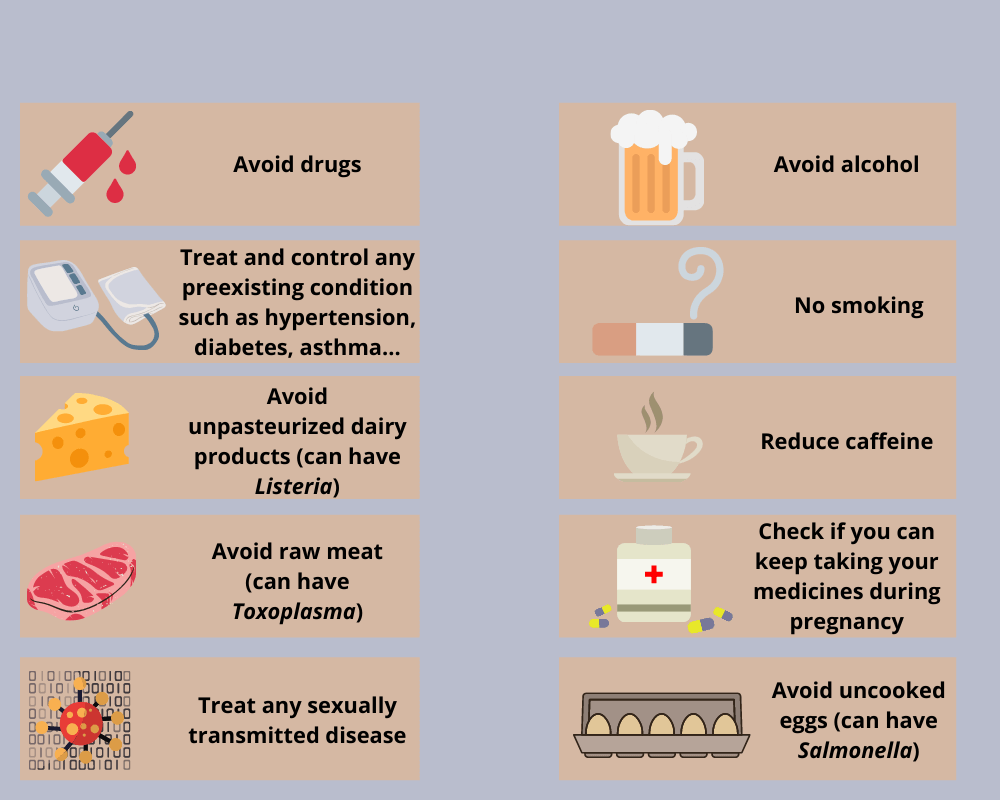
- Medicines: some drugs are harmful to the baby so you must check with your doctor to find out whether you should stop taking them. Some of the harmful ones are:
- Retinoids for acne
- Methotrexate for rheumatoid arthritis
- Non-steroidal anti-inflammatory drugs (NSAI) such as ibuprofen
- Finally, there are some other things to give up, like:
- Alcohol
- Drugs
- Smoking
- Excessive caffeine
3. 6 Foods You Cannot Forget In Your Pregnancy
The best diet for you is a regular healthy diet, only with some modifications:
-
- 400 more calories than usual. Your growing baby will consume those extra calories.
- Varied. It must include proteins, carbohydrates, healthy fats, vegetables, fruits, legumes… That is, it must be complete, balanced, and varied.
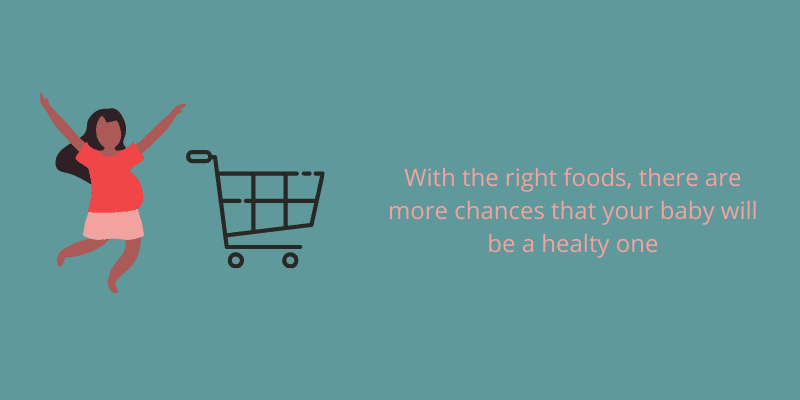
Your diet must include some vitamins and elements. It’s best to try to include them through your daily diet. However, sometimes your doctor will prescribe you some supplements, like folic acid.
- Fluid: water or juice. To stay hydrated.
- Fiber: pregnancy can cause constipation. The growing fetus can compress the rectum and other pelvic organs and cause constipation. To reduce constipation include foods with fiber like fruit and vegetables.
- Iron: it is a component for red blood cells. If you don’t get enough iron, you may get some degree of anemia. Some of the iron-rich foods are spinach, legumes, and red meat (remember to cook it well!).
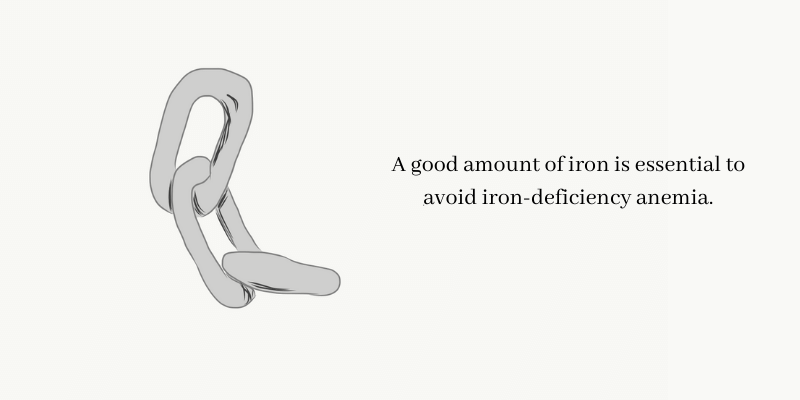
- Folic acid: folic acid helps prevent spina bifida and other birth defects. Some foods with high levels of folic acid are beets and broccoli. Also, there are some foods that can be “enriched” with it, such as cereals, rice, and orange juice (you have to make sure that they are folic acid fortified). Still, most of the time your doctor will prescribe you some folic acid supplement.
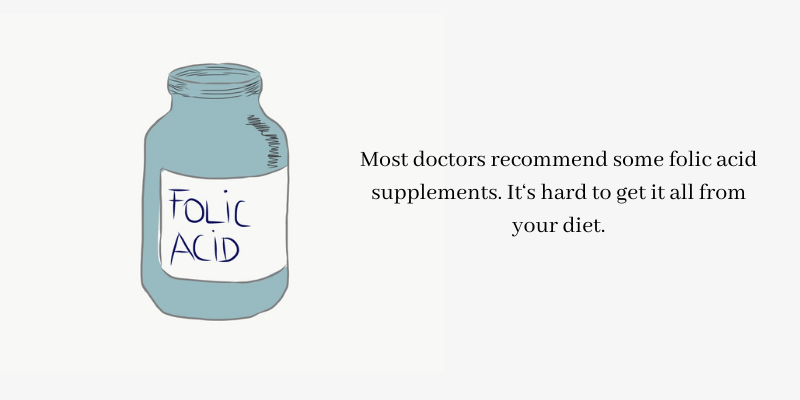
- Zinc: you always need zinc. However, when you are pregnant, you need extra zinc because your baby is taking some of it. Turkey, chicken, legumes, and eggs all have a good deal of zinc.
Here, we propose 6 foods that include all the extra nutrients that you need (remember you can still need some supplements, like folic acid):
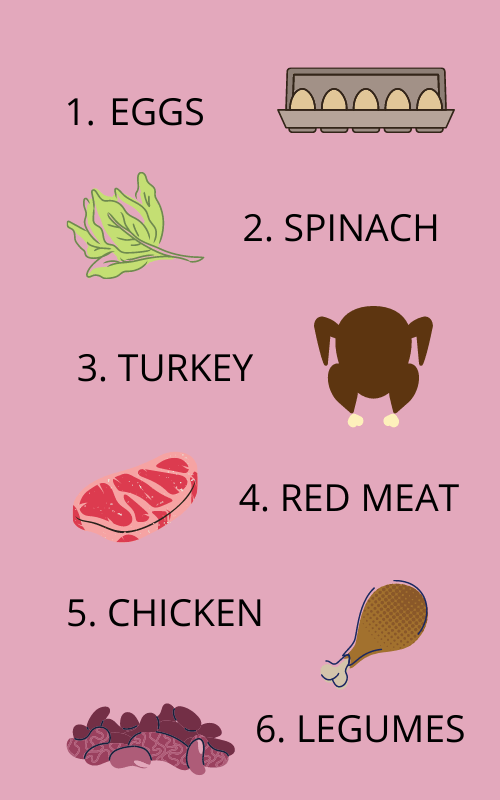
On the other side, there are some foods you should avoid. Those are:
- Unpasteurized dairies like blue cheese. As we said before, you can get Listeria.

- Raw (or partially cooked) eggs, for the risk of Salmonella.
- Undercooked meat, ham, and corned beef, for the risk of Toxoplasmosis.
- Tuna: just limit it and not eat too much of it, as it can mean too much mercury in your body.

- Alcohol: avoid at all costs. It can cause fetal alcohol syndrome (FAD) to your baby.
- Coffee: it‘s not necessary to avoid, but try to reduce. Maximum 2 cups of coffee a day (< 200 mg)

4. Exercise during pregnancy: Good or Bad?
We recommend light to moderate exercise during pregnancy. It will keep you fit and your mind clear and relaxed.
First, ask your doctor. He will consider your state, other conditions… The American College of Obstetricians and Gynecologists (ACOG) also recommends exercise, as they said in April 2020 (see their article):
“Physical activity is beneficial for most pregnant women. However, there are certain exercises and routines that must be adapted to new requirements”.
They recommend around half an hour of exercise a day. Besides keeping you in shape, exercise has other benefits such as a higher incidence of vaginal delivery and a lower incidence of some conditions such as gestational diabetes and hypertension.
If you want to know more we wrote a post dedicated entirely to exercise during pregnancy: Exercise During Pregnancy: Best Practices.

It is better to avoid those sports with “violent” movements or heavy lifting (for those Crossfit® lovers, try to postpone or at least adapt your routine). These exercises put too much pressure on the pelvis and abdomen, which is bad for your fetus.

Instead, it‘s better to include some other exercises that are more gentle with your joints and abdomen. They can include strength training, but in a controlled fashion that won’t harm you.
You can try swimming, walking… for aerobic exercise. For strength training, try yoga, pilates, or even weight lifting (using low weights and controlled motion).
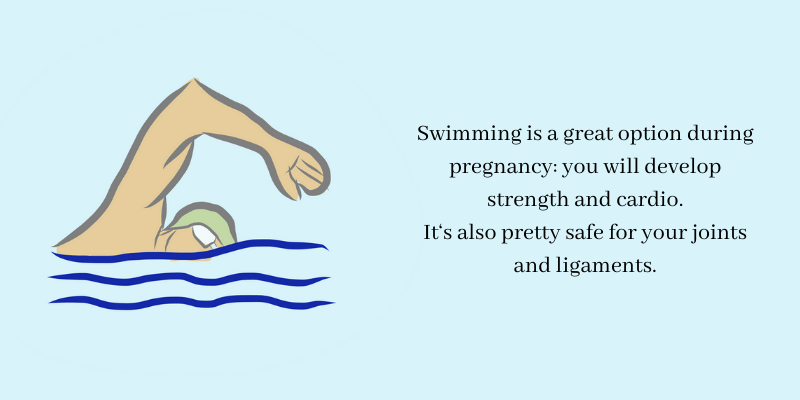
5. The 3 Trimester Timeline
Pregnancy is usually divided into 3 trimesters, with 3 months each. Let’s see what happens during each trimester, to both the fetus and the mother.
Remember that weeks are dated since the first day of your last period
1st Trimester (0-13 weeks)
First, the egg is fertilized by sperm, then it places into the lining of the womb. That’s called implantation. After that, during the first 3 months, the fetus grows “in miniature”. That means it will form all the organs, arms, legs, face but in a tiny size. Then, during the 2nd and 3rd trimesters, the baby will grow in size.
-
How does it feel?
First, you won’t feel anything. The first thing you‘ll probably notice is a missing period.
Then, you can feel breast tenderness. As time passes your breasts will become larger.
During the first months, you may feel tired and “morning sickness” with nausea and occasional vomiting. This improves after the first trimester, so don‘t worry. It will hopefully pass soon.
Although the fetus will start to move at the end of the first trimester, they will be so small that you won’t notice it.
The baby will weigh around 25g (which is soo little). Your womb (the baby and your uterus) will be slightly bigger than a lemon.
-
What’s happening inside?
In the beginning, the fetus forms from 2 simple layers, which then turn into 3 and then become the different organs, skin, limbs…
The fetus gets nutrients from a tiny yolk sac, until the placenta forms and takes over. Then the “food” and oxygen will come from the mother’s blood through the placenta.
Some of the first organs to appear are the heart and the neural tube (will turn into the brain and spine). Remember folic acid is essential for the formation of the neural tube and to avoid spina bifida.
Then the arms, legs, face (with the eyes, mouth, tongue…) and the skin will appear. The head will be one-third of the total size (their head is huge in comparison with the rest of the body).
At the end of the first trimester, the baby will be virtually “complete”, but with a tiny size.
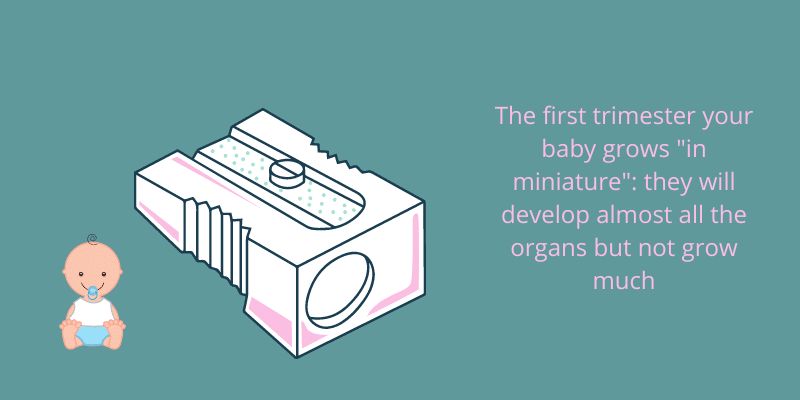
-
Things to do during the first trimester
- Contact your doctor: talk about your preexisting conditions, medicines you take, what supplements you should take…
- Take folic acid supplements: usually 400 micrograms/day (IF your doctor says so).
- Make your first midwife appointment, it should be around 10 to 16 weeks.
- Visit your dentist to check your mouth and gums.
- At around 10-14 weeks, you may be offered a screening blood test for chromosopathies. They are used to detect if your baby will have Down syndrome, Turner syndrome, and others.
- You can get an ultrasound (U.S) at 8-11 weeks. It will be useful to date your baby more accurately (and therefore know the probable date of birth). It won‘t reveal the gender in most cases. If you want to have a more clear view of the tests you must take during pregnancy we recommend that you check this post we wrote about screening tests.
2nd Trimester (14- 27 weeks)
-
How does it feel?
Your womb will get progressively larger and you may have some compressive symptoms too.
It’s frequent to feel backache and pelvic pain from the compression against your pelvic ligaments. For the same reason, constipation is also common.
As the womb starts compressing your bladder, you may need to pee more often than usual. Also, you might get some urinary tract infections (UTI). If you do, you must treat them.
As the pelvic veins are also compressed, you can get piles (=hemorrhoids).
You can also get a dark line down the middle of your tummy: it‘s called the “linea nigra” (in Latin black stripe).
Around the 20th week, you can start to feel your baby moving and kicking. A couple of weeks later, you will notice how your baby is at times asleep (still and quiet) and other times awake (moving around and kicking).
By this time, you will start to “really look pregnant”. So far, people may not notice your pregnancy. Not anymore.
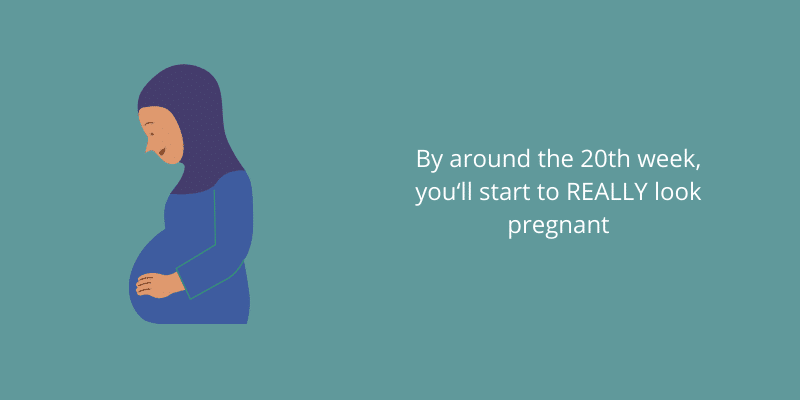
Other things you can feel:
- Headache: if it’s very intense, contact your doctor. Most of the time it‘s normal, but sometimes it could be a sign of eclampsia.
- Your breasts start to leak some milk, because of the hormones.
- Stretchmarks on your skin.
- Swelling of your feet, hands, face…
-
What‘s happening inside
The baby is growing slowly in size and is starting to develop the organs.
For example, they are starting to swallow amniotic fluid. Then it is absorbed and filtered through the kidneys. The result? Pee. The fetus pees into the surrounding fluid. But there‘s nothing to worry about because that pee is sterile (as everything else in there).
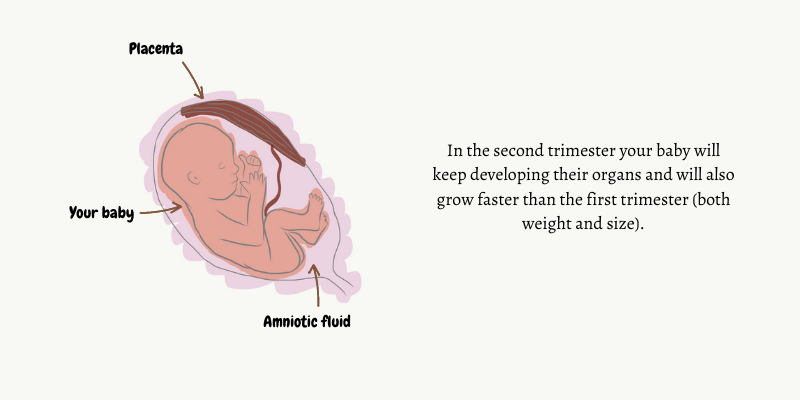
By this time the fetus is developing their senses and starting to hear noises and music. They can even react to it with kicks and movements. Also, they start to see (it’s dark in there but they can see some external light through your tummy).
They will start moving their hands as well, grasping…
During the second trimester, the baby is covered by a thin dark hair called lanugo (a pretty scary image isn’t it?). It’s thought to keep the baby worm inside the amniotic fluid.
Most importantly, by the 24th week, the baby can survive if we need to carry out an emergency C-section. It’s not the best option, of course. But if there were no other choice (like if the mother’s life was in danger) then the baby already has chances to survive outside. With a lot of medical support and intensive care units.
-
Things to do during the second trimester
- Exercise: apart from swimming, walking, isometrics… you should also do some pelvic floor exercises. They will help with labor, making it shorter and less exhausting.
- Whooping vaccination: it is usually given at 28 weeks. More about it here.
- 20-week ultrasound: we use it to check the baby’s face, bones, heart, brain, spinal cord, kidneys, and abdomen. It allows the gynecologist to detect some abnormalities, such as spina bifida, heart abnormalities, anencephaly…
- 16-week blood test: a screening blood test is done between the 16th and 18th week. It detects some markers such as alpha-fetoprotein (AFP), estriol, and others. If these markers are high, then more studies are needed, and sometimes, even an amniocentesis (a sample of the amniotic fluid is obtained and studied).
3rd Trimester (28-40 weeks)
One last push and it’ll be done! By this time the baby could survive if he were born suddenly. They would still need extra support but still could make it.
At around 37 weeks the baby is full-term, and birth usually happens from 38 to 42 weeks.
-
How does it feel?
The baby will reach their greater size, and the compression will be maximum, too. You can have acid reflux and shortness of breath (because of the compression upwards, against the stomach and lungs).
You’ll need to pee very often because your bladder will be pushed too.
Another thing you can have, and it’s normal, is nosebleeds. If they only happen from time to time and you don’t bleed a lot, that’s ok.
Finally, it’s common to experience leg cramps, which are pretty uncomfortable. They feel like electric discharges traveling through your legs.
During the last weeks, you can feel Braxton Hicks contractions. They are a light sudden tightening of your lower tummy. Don’t mistake them for labor contractions.
If the contractions become regular, painful, happen every 5 minutes and last at least 60 seconds, labor is probably starting
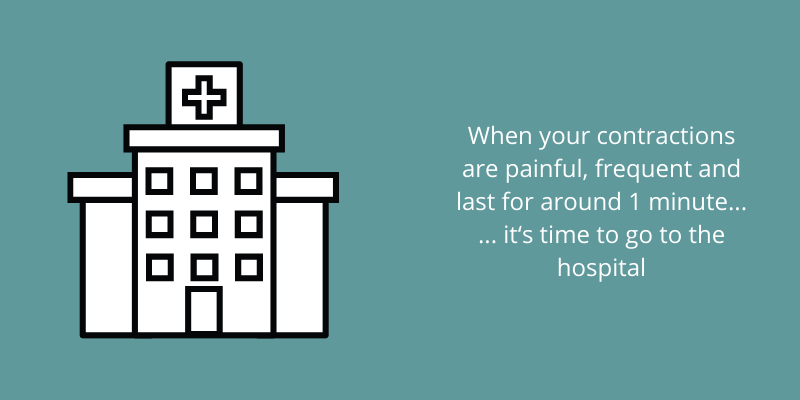
-
What’s happening inside
During this last semester, the final development of the organs takes place. All the bones harden except the skull, that won’t fuse until after birth to allow the head to accommodate to the birth canal.
The lanugo, that thin layer of dark hair, disappears (thank god).

The baby will develop their sucking reflex and start sucking their thumb (sometimes seen in the ultrasound)
As weeks go by, the baby’s head will start to point downwards (cephalic presentation) and then will move down into your pelvis, to prepare for labor.
-
Things to do during the third trimester
At the 28th week you should have your antenatal appointment, where they’ll:
- check your blood pressure: to exclude (pre)eclampsia.
- measure the proteins in your urine: another sign of pre-eclampsia if they are high.
- give you the results from the previous screening tests.
6. One Last Effort: Labor
Labor usually starts when you begin noticing regular, painful, sustained contractions.
In the beginning, it doesn’t hurt much. The first thing to happen is that your cervix starts to dilate.
Then, when the cervix is dilated (10 cm), the baby must go down. It’s no use ˝pushing˝ before the baby is in the right position, down in the pelvis.
Once it is in place, you must push when you feel contractions, and rest in between. That way, you’ll avoid getting exhausted and your next push will be more effective.
Sometimes, the baby’s head will be too big for the vagina and the gynecologist will have to make a cut in the border of your vagina. This is called an episiotomy.
As savage as this sounds, there is a reason. If the head comes out and tears through your vagina into the pelvic floor, it can damage important structures.
For example, it can tear your anal sphincter, and you may lose continence (can’t hold your poo). With an episiotomy, the doctor can make the cut exactly in the right direction and the right length.
After birth, they will stitch it and it will heal.
7. I Have Some Preexisting Conditions… Is It Gonna Be OK?
Preexisting conditions are diseases that you already have before getting pregnant. They can be asthma, diabetes, epilepsy, depression… Actually, any chronic disease would be included.
If you have preexisting conditions there are two important things that you need to take care of:
- First, you have to keep them in check. So, if you suffer from hypertension, you should control your blood pressure levels. If you are diabetic, control your sugar levels… and so on.
- Second, you need to check whether the necessary medication can be taken during pregnancy. Because some medications can be harmful to the baby. It is a delicate matter that must be consulted with your doctor.
-
- For example, epilepsy medication can (sometimes) cause some damage to the baby. However, having seizures during pregnancy can be a lot more dangerous, as they can leave the baby without oxygen for some time. So it‘s usually preferred to keep the medication for epilepsy. In any case, you must consult your doctor, who will consider how often you have seizures, how intense, etc.
- Another example would be VIH. If you have VIH and are pregnant, taking the right meds can lower the risk of transmission to 1%, which is not bad at all!
8. The Enemy: Pregnancy Complications
There are plenty of complications that can happen during pregnancy. But don’t worry because most of the time everything is going to be ok. We don’t mean to frighten you, just let you know the possible complications and how to detect them early.
- Hyperemesis gravid: you have severe nausea and can’t stop vomiting. Sometimes it requires hospitalization for I.V. fluid because all the vomiting may cause dehydration. It usually gets better after the 20th week, and there are also some medicines that can help.
- Gestational diabetes: this kind of diabetes comes during pregnancy (and usually stops after it). You may feel very hungry, thirsty, and peeing a lot. These are typical signs of diabetes (polydipsia, polyuria, and polyphagia). Another way to detect it is through a screening test, where they find abnormally high levels of sugar in your blood.
- Pre-eclampsia: it consists of high blood pressure and kidney malfunction, with loss of proteins through urine. The only solution is labor, so depending on the week you are and how severe the symptoms are, the doctor may decide to wait and watch closely or go for a preterm induction.
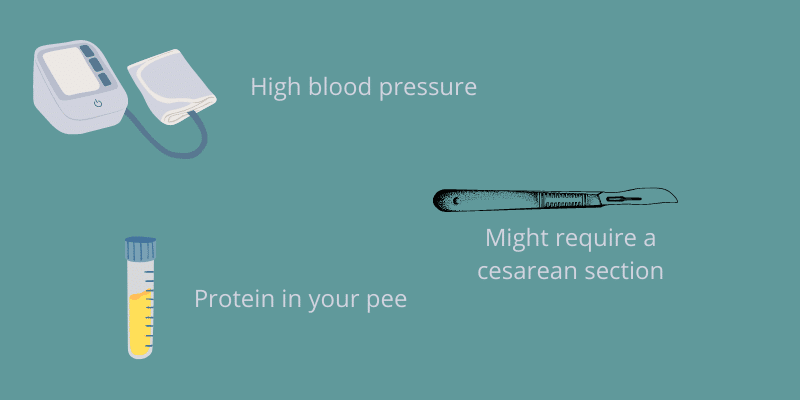
- Ectopic pregnancy: when the egg doesn’t implant inside the uterus but somewhere else, for example in the Fallopian tubes. It is detected in early weeks as you will feel pain, vaginal bleeding, etc. An ectopic pregnancy can’t develop normally and must be removed through surgery or drugs.
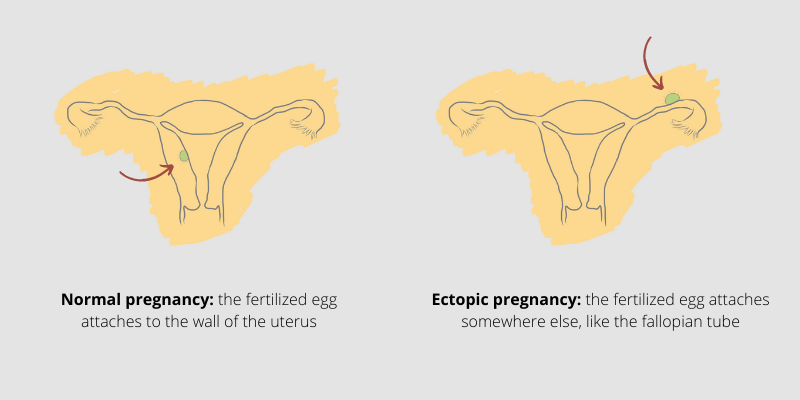
- Miscarriage: It’s a pregnancy loss before 20 weeks, sometimes even before the woman realizes she is pregnant.
- Placenta previa: the placenta is placed between the baby and the cervix (which is the “exit door” for the baby during labor). It may then prevent the baby from coming out, in which case you may need a cesarean section.
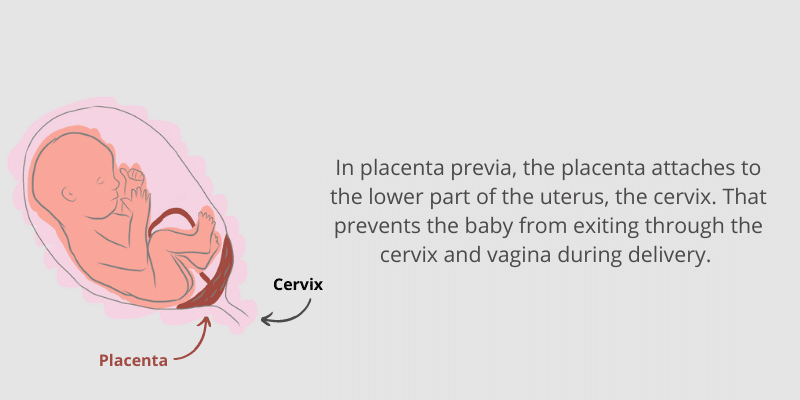
- Placental abruption: the placenta separates from the uterine wall. When this happens, the placenta can no longer provide oxygen and nutrients to the baby. Remember the baby doesn’t breathe with their lungs until birth (there is no air inside the amniotic cavity). If the abruption is small, affecting one part of the placenta, bed rest can be enough. If it is larger, it can require induction.
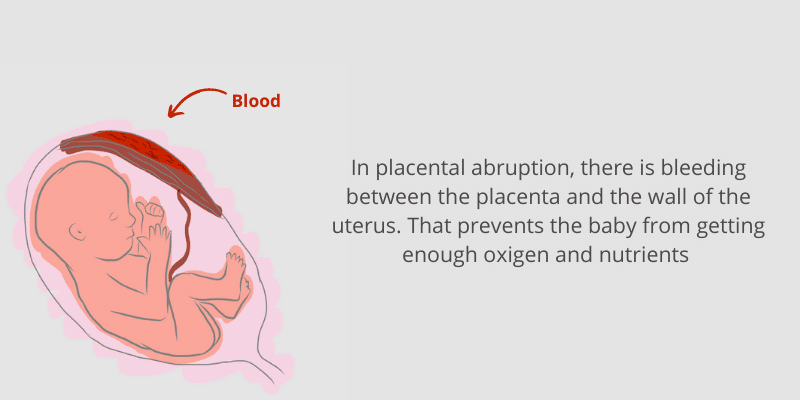
We made a new post exclusively about pregnancy complications after this one, where we explain them with more detail. If you wanna check it just click here: Pregnancy Complications: when things go wrong.
Well, that’s it for now. Congratulations if you made it this far, because that means you really are interested in knowing about what’s going on inside you.
Remember that:
“Luck favors the prepared”
Leave a Reply